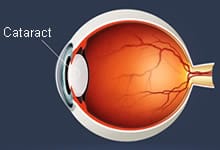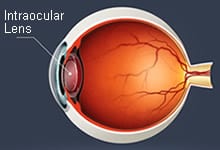A cataract is a common condition that causes a clouding of the eye's natural lens. Cloudiness develops as a result of a buildup of protein in the lens. Cataracts affect millions of people each year, including more than half of all Americans over the age of 65.

Cataracts cause a progressive, painless loss of vision. The lens clouds naturally as we age, causing people over the age of 65 to see a gradual reduction of vision. Cataracts can have a significant impact on activities of daily living, and should be addressed when your vision is affected. Everyone will develop cataracts with time, but they may also be a result of injury, certain medications, illnesses (such as diabetes), prolonged exposure to ultraviolet light, and smoking.
Your doctor may perform a series of tests in order to diagnose a cataract. A dilated eye exam will be performed to test the vision and to examine the condition of the lens and other parts of the eye. Your doctor may also perform tonometry, a procedure that measures the pressure in the eye.
If visual impairment begins to interfere with your ability to read, work or do the things you enjoy, you may want to consider cataract surgery to restore your vision. Cataract surgery is one of the most commonly performed surgical procedures in the US, and can be performed quickly and easily with a very high success rate and a minimal risk of complications.
Cataract surgery is a minimally invasive procedure that involves numbing the eyes with anesthesia and then making a tiny incision into which an ultrasonic probe is inserted. The probe breaks up, or emulsifies, the cloudy lens into tiny pieces and then removes them out of the eye. Once the cloudy lens has been removed, a new artificial lens is implanted into the eye. This lens is known as an intraocular lens (IOL), and is inserted through the same incision that the old lens was removed from. Surgery usually takes only a few minutes to perform and is painless for most patients. After the procedure, a shield is placed over the eye. Patients return home the very same day, but will need someone to drive them home. For the next few days, you may experience itching, mild itching, foreign body sensation, and sensitivity to light. You will be on prescription eye drops to help the healing process and to reduce the risk of infection.
There are different types of IOLs available to help each patient achieve the best possible results from his or her cataract surgery. In the past, the only available lens was a monofocal IOL, which provides focus on objects at a single distance, either near or far, and does not correct astigmatism. This IOL is still used, and these patients have to rely on glasses or contact lenses after surgery in order to see clearly at all distances. Some IOLs can correct astigmatism. These astigmatism-correcting IOLs are called Toric IOLs. There are also IOLs called extended-depth-of-focus IOLs, which provide a continuous range of high-quality vision - from intermediate to far - and may reduce the frequency of wearing glasses. There are also multifocal IOLs that provide multiple points of focus - near, intermediate, and distance. These choices were not always available for cataract patients.
If left untreated, cataracts will worsen over time and may lead to permanent vision loss or even blindness. It is important to see your eye doctor regularly in order to detect cataracts early and to plan an effective treatment method.
Premium Intraocular Lenses (IOLs)

There are a wide range of replacement lenses available to cataract patients, each offering different advantages for your post-surgery vision. The most effective lens depends on each patient's individual preferences and goals for their vision. Before premium lenses, patients were unable to see clearly at both near and far distances without the use of eyeglasses or contact lenses.
Most lens implants are monofocal, meaning that they have only one focal point and could not adjust to varying distances. New advances in technology have allowed for the development of extended depth of focus and astigmatism-correcting IOLs. Premium lens implants are ideal for cataract patients who are also suffering from presbyopia and want a replacement lens that provides a full range of clear vision.
Extended depth of focus lens implants use technology that can lessen your dependency on glasses for both near and far vision and points in between. There are different types of EDOF or multifocal IOLs, including Tecnis Symfony® Extended Range of Vision IOL, Alcon Vivity IOL, and Alcon PanOptix. This may be a good option if you prefer not to wear glasses after cataract surgery. However, these IOLs are not right for everyone, so make sure to discuss your options with your surgeon. These IOLs work best in patients who do not have other eye diseases like macular degeneration, severe dry eye, and glaucoma. If you have astigmatism and are interested in one of these IOLs, astigmatism correction will also need to be addressed at the time of surgery.
When a patient has both cataracts and astigmatism, a toric implant may be the best option for correcting distance vision to lessen the need for glasses. Our cataract surgeons, Dr. Jahnle and Dr. Krespan, use an implant called the Tecnis® or Alcon Toric IOL. Discuss these lenses with your surgeon if you think this may be an option for you.
Cataract Surgery – Frequently Asked Questions
The best time to consider cataract surgery is when you cataracts begins to affect your activities of daily life. This could include difficulty seeing while driving at night or watching television, difficulty seeing small print on your cell phone, medicine bottle, or labels, or difficulty seeing the computer screen.
Cataract Surgery has a relatively speedy recovery, but there are a few minor restrictions after cataract surgery. Patients are advised to avoid swimming for 1 week and should not put makeup around the eye for 1 week after surgery. Patients are also required to use eye drops after surgery (usually up to 1 month after surgery). You may resume all other normal daily activities as soon as the next day after surgery.
Most surgeons will have you use eye drops for 4 full weeks after surgery. After surgery, there are 3 different types of drops that you will be using (Antibiotic, Anti-inflammatory and Steroid). These drops will be used up to 4 times per day for the first week after surgery and will taper off each week until complete. Some doctors also require patients to start using eye drops in the day or two leading up to surgery.


